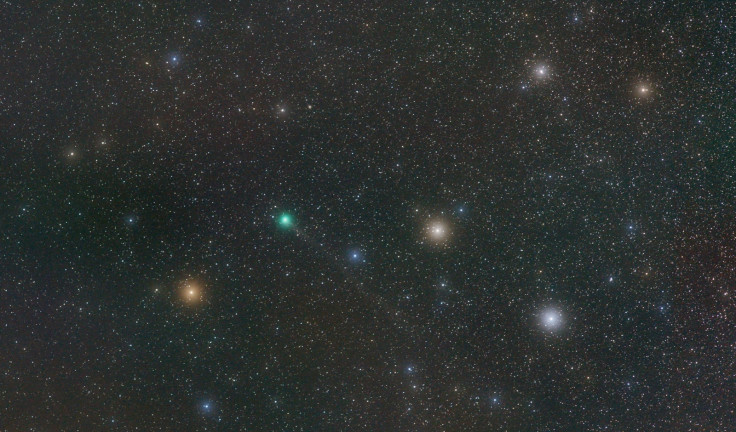Comet Lovejoy: How and where to watch once-in-a-lifetime C/2014 Q2 soar closest to Earth

The newly discovered Comet Lovejoy will light up the night sky this week as it reaches its closest position to Earth - the next time that will happen will be in 8,000 years.
Formally known as C/2014 Q2, the comet will make its closest approach on 7 January at 43.6 million miles, according to Nasa's Jet Propulsion Laboratory.
Skywatchers in the southern hemisphere got the first glimpse of Lovejoy, which is now brightening and can now be seen from latitudes in the northern hemisphere.
The comet, which was discovered in August by Australian amateur astronomer Terry Lovejoy, is travelling around 15 miles per second and has been billed as one of the brightest comets in years.
What do we know about the comet?
Lovejoy was discovered on 17 August 2014 using a Schmidt-Cassegrain telescope, at apparent magnitude 15 in the southern constellation of Puppis. It is the fifth comet discovered by the astronomer.
It is a long-period comet, with an orbit that astronomers have calculated to take about 11,500 years. After leaving the planetary region around 2050, however, its orbital period will shorten to around 8,000 years.
The comet is expected to make its closest approach to the Sun on 30 January at a distance of 1.29 AU (one astronomical unit – AU – is the distance from the Earth to the Sun).

Will we be able to see it?
Although the comet is bright and may reach up to 4.6 magnitude, those hoping to spot Lovejoy will have a better chance of doing so with binoculars or a small telescope.
For skywatchers living in areas with little light pollution, the comet may be visible with the naked eye – although this largely depends on weather conditions.
Heavy cloud cover in the UK this week could ruin the view for those without specialised equipment. You can check BBC Weather for updates on conditions in the UK and the National Weather Service for the forecast in the United States.
In the latter two weeks of January, however, the brightening comet will become more visible to the naked eye - with less interference from moonlight.
For those wanting to spot the comet from the comfort of their own home, the Virtual Telescope Project will host a live online streaming of the comet on 11 January.
Comet #Lovejoy Q2 by Gerald Rhemann from Farm Tivoli, Namibia, SW #Africa Dec 21. http://t.co/MzRYkXBNTM pic.twitter.com/IWgrUW9DAM
— Epic Cosmos (@EpicCosmos) December 23, 2014How you can see the comet?
Throughout this month, Lovejoy will be in an excellent place for viewing from the northern hemisphere. From 7 January, the comet will move into the north west of Lepus into the constellation Eridanus the River.
Lovejoy is currently passing near Orion, one of the easiest constellations to spot because of its short row of three medium-brightness stars, called Orion's Belt. By 9 January, the comet will cross the celestial equator and move into Taurus.
Sky and Telescope offers charts and maps to show where to look for C/2014 Q2 as it moves away from the horizon over the course of this month. The brightest period of the comet will be around the middle of January, with prime viewing conditions with the New Moon on 20 January.
By February, the comet is expected to disappear along its orbit. It will head back towards the Oort Cloud, in the outermost reaches of the solar system, and will not reappear until around 10,015 CE.
Why does Comet Lovejoy have a green glow?
To the naked eye, the comet will appear grey. For those using cameras with a long exposure, the comet appears as a green wash of colour, due to the diatomic carbon fluorescing in ultraviolet sunlight in the near-vacuum of space. The tail of the comet is tinted blue, from fluorescing carbon monoxide ions.
Astronomer Dr Tanya Hill, of the University of Melbourne, explained Lovejoy's eerie green glow in the Conversation: "The colour is likely due to the presence of two gases – cyanogen (CN)2 and diatomic carbon (C2) – which glow green when their molecules are ionised or excited.
"Ionisation causes electrons within the molecules to gain energy and when the electrons drop back down to their normal state, they give off light of a certain wavelength. For these molecules, they emit green light and since they are very strong emitters, their green colour dominates the comet."
Where is best to catch a glimpse of the comet?
Dark Sky Discovery has a map of areas with little light pollution for the best chance of spotting Comet Lovejoy over the coming weeks.
Below are various dark sky areas and reserves around the UK, which are popular with astronomers.
London: The WaterWorks Nature Reserve, between Clapton and Leyton Midland Road rail station. You can also head out of the city to Surrey or Kent, to reduce the likelihood of light pollution.
Manchester: Heaton Park is the largest municipal park in the city, covering 600 acres. It also contains an astronomy club.
Birmingham: Warley Woods is accessible by bus or car from the city. Those driving should take the A456 Hagley Road westbound from the centre.
Newcastle: Northumberland National Park is an internationally designated Dark Sky Park.
Cardiff: Brecon Beacons offers some of the darkest skies in the UK. For more information on the best areas within the National Park, visit Breconbeacons.org.
Belfast: Oxford Island National Nature Reserve is around 25 miles from the city, located on the shores of Lough Neagh.
Edinburgh: Newbattle Abbey College, off the B703 Newbattle Road, is part of Dark Sky Scotland.
© Copyright IBTimes 2025. All rights reserved.






















